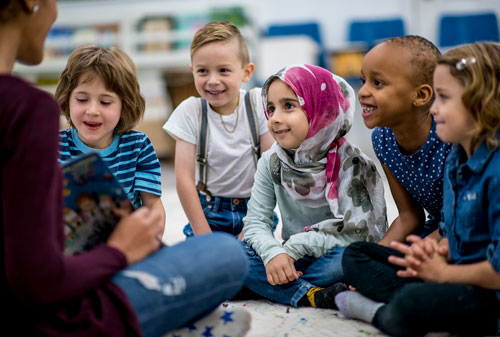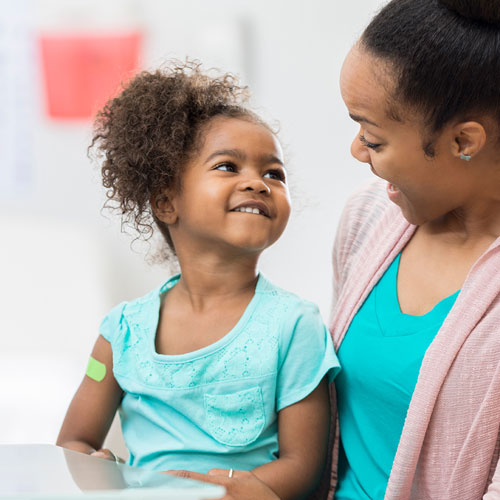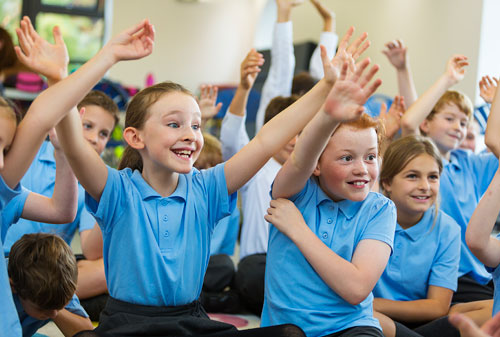




In his book 'A Parents' and Teachers' guide to Bilingualism', Professor Colin Baker says, “Young children pick up languages so easily. Language is acquired unwittingly, subconsciously. Language among children is caught rather than taught. The process is not learning but acquisition...”
Children in Welsh-medium settings in the early years acquire new languages through the language immersion method, which is a way of introducing a second language. Children will be immersed in a language when they receive their education in a language that is different from the language used at home. Welsh is used as they play and interact, and take part in activities. This means that children are surrounded by the language and acquire it in a natural way without them realising.
Practitioners have a very important role in supporting children to acquire a new language. The linguistic development of children depends on them consistently hearing the Welsh language in all activities. Practitioners need to join in with the children's activities to offer them linguistic clues.
Practitioners need to speak Welsh all the time in order for the children to be surrounded by the language. Practitioners are linguistic role models for children, which means they need to speak Welsh with the other staff. If they don't do this, children won't hear practical examples of the language being used. It's important that practitioners don't use the 'sandwich' method of presenting Welsh, which is to say the word/information in Welsh-English-Welsh, e.g. ‘diod-drink-diod’. By using this approach, children will realize that they don't need to take any notice of the new language and will focus on the language they already know.

Dywed yr Athro Colin Baker yn ei lyfr ‘A Parents’ and Teachers’ guide to Bilingualism’, “Young children pick up languages so easily. Language is acquired unwittingly, subconsciously. Language among children is caught rather than taught. The process is not learning but acquisition...”
Mae plant mewn lleoliadau cyfrwng Cymraeg yn y blynyddoedd cynnar yn caffael ieithoedd newydd trwy’r dull trochi iaith, sef ffordd o gyflwyno ail iaith. Bydd plant yn cael eu trochi mewn iaith pan fyddant yn derbyn eu haddysg mewn iaith sy’n wahanol i iaith y cartref. Caiff y Gymraeg ei defnyddio wrth iddynt chwarae a rhyngweithio, a chymryd rhan mewn gweithgareddau. Mae hyn yn golygu bod plant yn cael eu hamgylchynu gan yr iaith ac yn ei chaffael mewn ffordd naturiol heb iddynt sylweddoli.
Mae gan ymarferwyr rôl bwysig iawn wrth gefnogi plant i gaffael iaith newydd. Mae datblygiad ieithyddol plant yn dibynnu ar glywed y Gymraeg yn gyson ym mhob gweithgaredd. Mae angen i ymarferwyr ymuno gyda gweithgareddau’r plant er mwyn cynnig cliwiau ieithyddol iddynt.
Er mwyn i blant gael eu hamgylchynu gan yr iaith mae angen i ymarferwyr siarad Cymraeg drwy’r amser. Mae ymarferwyr yn fodel rôl ieithyddol i blant, sy’n golygu bod angen iddynt siarad Cymraeg gyda’r staff eraill. Os nad ydynt yn gwneud hyn, ni fydd plant yn clywed enghreifftiau ymarferol o’r iaith yn cael eu defnyddio. Mae’n bwysig nad yw ymarferwyr yn defnyddio’r ‘dull brechdan’ o gyflwyno’r Gymraeg, sef dweud y gair/gwybodaeth mewn Cymraeg-Saesneg-Cymraeg, e.e. ‘diod-drink-diod’. Drwy arfer gyda’r dull hwn, bydd plant yn dod i ddeall nad oes angen iddynt gymryd sylw o’r iaith newydd ac yn canolbwyntio ar yr iaith maent yn ei wybod yn barod.

For children to learn a new language, it's essential that they become immersed for them to become bilingual. Therefore, it's vitally important for practitioners to ensure that they always speak Welsh while the children are in the setting. There are several reasons for this, for example:
When immersed in a new language, children move through several stages. These stages can vary from child to child, depending on their personal experiences or circumstances.
I blant ddysgu iaith newydd, mae’n allweddol eu bod yn cael eu trochi er mwyn datblygu i fod yn ddwyieithog. Felly, mae’n hanfodol bwysig i ymarferwyr sicrhau eu bod yn siarad Cymraeg drwy’r amser tra bod y plant yn y lleoliad. Y mae sawl rheswm am hyn, er enghraifft:
Wrth gael eu trochi mewn iaith newydd, mae plant yn symud drwy sawl cam. Gall y camau hyn amrywio o blentyn i blentyn, yn dibynnu ar eu profiadau neu eu hamgylchiadau personol.

A child's individual circumstances can have an impact on the way they acquire the immersion language.
The language used at home is important as a child learns a new language. If the parents/carers can speak the immersion language, they can offer the child support by practicing the language, reading books together, listening to music, playing games, and so on.
If the child has regularly heard the immersion language before attending the setting, he can build on this.
One of the main elements of a child's language acquisition is the setting's environment and how comfortable the child is in this location. Practitioners should ensure that linguistic resources are available for children with additional learning needs.
When learning a new language, children need the support of parents and carers. It's therefore essential that they are included in the life of the setting. Parents and carers play an important role in the process of their child acquiring a language. By building a close relationship with the setting, this helps them feel comfortable enough to ask questions or discuss any concerns they may have about their children's language development. To strengthen the relationship, parents/carers can occasionally volunteer at the setting. This is an effective way of learning the immersion language with the child, as well as building the parent/carer's confidence.
Many early years settings encourage parents/carers to participate in their children's language journey by:
Mae amgylchiadau unigol plentyn yn gallu cael effaith ar y ffordd mae’n caffael yr iaith drochi.
Mae iaith y cartref yn bwysig wrth i blentyn ddysgu iaith newydd. Os yw’r rhieni/gofalwyr yn gallu siarad yr iaith drochi, maent yn gallu cynnig cefnogaeth i’r plentyn drwy ymarfer yr iaith, darllen llyfrau gyda’i gilydd, gwrando ar fiwsig, chwarae gemau, ac yn y blaen.
Os yw’r plentyn wedi clywed y Gymraeg yn gyson cyn mynychu’r lleoliad, mae’n gallu adeiladu ar hyn.
Un o brif nodweddion caffael iaith plentyn yw amgylchedd y lleoliad a pha mor gyfforddus yw’r plentyn yn y lleoliad hwn. Dylai ymarferwyr sicrhau bod adnoddau ieithyddol yn eu lle ar gyfer plant sydd ag anghenion dysgu ychwanegol.
Wrth ddysgu iaith newydd, mae plant angen cefnogaeth rhieni a gofalwyr. Felly, mae’n hanfodol eu bod yn cael eu cynnwys ym mywyd y lleoliad. Mae rhieni a gofalwyr yn chwarae rhan bwysig yn y broses o’u plant yn caffael iaith. Wrth feithrin perthynas agos gyda’r lleoliad, mae hyn yn eu galluogi i deimlo’n ddigon cyfforddus i ofyn cwestiynau neu drafod unrhyw bryderon sydd ganddynt ynglŷn â datblygiad ieithyddol eu plant. Er mwyn cryfhau’r berthynas, gall rhieni/gofalwyr wirfoddoli yn y lleoliad yn achlysurol. Mae hyn yn ffordd effeithiol o ddysgu’r iaith drochi gyda’r plentyn, yn ogystal â magu hyder y rhiant/gofalwr.
Mae sawl lleoliad blynyddoedd cynnar yn annog rhieni/gofalwyr i gymryd rhan yn nhaith ieithyddol eu plant drwy:

It's vitally important to respect the child’s home language and try to make learning Welsh fun. Children who are educated in a language that is different to the home language have a unique identity. It's important that practitioners value the identity as well as the child's right to use their language of choice so that they enjoy speaking the language and learn it in a completely natural way. These principles are supported by legislation that makes it unlawful to punish children for not speaking Welsh, namely:
Although it's the immersion language that should always be used with the children, there are times when the child's natural language needs to be spoken, in circumstances such as:
Mae’n hanfodol bwysig parchu iaith gartref plant a cheisio gwneud dysgu’r Gymraeg yn hwyliog. Mae plant sy’n derbyn eu haddysg mewn iaith sy’n wahanol i iaith y cartref gyda hunaniaeth unigryw. Mae’n bwysig bod ymarferwyr yn gwerthfawrogi’r hunaniaeth yn ogystal â hawl plant i ddefnyddio eu dewis iaith fel eu bod yn mwynhau siarad yr iaith a’i dysgu mewn ffordd hollol naturiol. Mae’r egwyddorion hyn yn cael eu cefnogi gan ddeddfwriaeth sy’n ei gwneud yn anghyfreithlon i gosbi plant am beidio â siarad Cymraeg, sef:
Er mai’r iaith drochi y dylid ei defnyddio pob amser gyda’r plant, mae adegau pan fydd angen siarad iaith naturiol y plentyn, mewn amgylchiadau megis:

Being bilingual or multilingual from an early age means that moving from a Welsh-medium playgroup or nursery to a Welsh-medium or bilingual school will be a natural development for children. This is especially true if several children from the same group move together. Progression is very important to children.
Being bilingual means that children from non-Welsh speaking backgrounds can read, write, speak, understand and use Welsh as well as those children from Welsh speaking homes. Bilingual children tend to do well within the curriculum and perform better in examinations. Bilingual or multilingual children can be more flexible, sensitive and creative as they have an understanding that there is more than one word to describe an object or concept. Learning a second language from an early age helps children hear different languages and helps them learn a third or fourth language as they grow older.
When both parents speak different languages, a bilingual child can communicate and develop a close relationship with both. One of the benefits of being bilingual is the opportunity of being part of two cultures which can lead to a better understanding of different traditions and ways of thinking.
There are many other benefits to being bilingual or multilingual:
Mae bod yn ddwyieithog neu’n amlieithog o oedran cynnar yn golygu bydd symud o gylch meithrin neu feithrinfa cyfrwng Cymraeg i ysgol cyfrwng Cymraeg neu ddwyieithog yn ddatblygiad naturiol i blant. Bydd hyn yn wir yn enwedig os oes nifer o blant o'r un grŵp yn symud gyda'i gilydd. Mae dilyniant yn bwysig iawn i blant.
Mae plant dwyieithog yn tueddu i gyflawni’n uchel o fewn y cwricwlwm ac i berfformio’n well na phlant uniaith mewn arholiadau. Gall plant dwyieithog neu amlieithog fod yn fwy hyblyg, sensitif a chreadigol gan fod ganddynt ddealltwriaeth fod mwy nag un gair i ddisgrifio gwrthrych neu gysyniad. Mae dysgu ail iaith o oed cynnar yn helpu plant i allu clywed gwahanol ieithoedd a’u cefnogi wrth ddysgu trydedd neu bedwaredd iaith wrth iddynt dyfu’n hŷn.
Pan fydd y ddau riant yn siarad ieithoedd gwahanol, gall plentyn dwyieithog gyfathrebu a datblygu perthynas agos gyda’r ddau. Un o fanteision bod yn ddwyieithog yw'r cyfle i fod yn rhan o ddau ddiwylliant sy’n gallu arwain at well dealltwriaeth o wahanol draddodiadau a ffyrdd o feddwl.
Mae sawl mantais arall i fod yn ddwyieithog neu’n amlieithog: